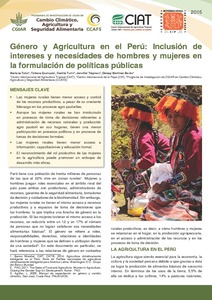Final report of the Task Group on GBIF Data Fitness for Use in Agrobiodiversity
Human wellbeing and food security in a changing climate depend on productive and
sustainable agriculture. For this, policies based on analyses and research results are vital to
establish conservation priorities of natural resources that underpin the enhancement of
sustainable food production. Therefore, data from agrobiodiversity and wider biodiversity sources
Financing sustainable agriculture and mitigation
Key messages:
- Smallholder farmers and forestry producers have a crucial role to play in food security, sustainable land use and emissions reductions initiatives.
- Producers and investors alike require appropriate incentive structures to facilitate participation in sustainable land use initiatives.
- A networked financing approach—Inari—may provide an innovative response to financing sustainable land use via intelligent diversification and addressing the finance needs of smallholders.
Forging partnership to enhance the relevance of Ethiopian graduate schools research in agriculture: Report on stakeholder workshop, Hawassa University, Ethiopia, 23-24 October 2008
Gender analysis in agricultural research : Proceedings international workshop, Palmira, Valle del Cauca, Colombia, 1991
Gender and Institutional Aspects of Climate-Smart Agricultural Practices: Evidence from Kenya
This paper analyses gender differences in awareness and adoption of climate-smart agricultural (CSA) practices. It examines what factors are associated with the likelihood of adoption of a wide range of CSA practices for 376 women and 375 men in two different areas of Kenya. This information is aimed at improving the targeting and design of interventions that are trying to achieve greater and more equitable agricultural development in East Africa and elsewhere.
General evolution of the agricultural potential of the Bolivian Amazon
Género y Agricultura en el Perú: Inclusión de intereses y necesidades de hombres y mujeres en la formulación de políticas públicas
Perú tiene una población de treinta millones de personas de las que el 22% vive en zonas rurales. Mujeres y hombres juegan roles esenciales en el ámbito rural del país pues ambos son productores, administradores de recursos, garantes de la seguridad alimentaria, tomadores de decisión y cuidadores de la biodiversidad. Sin embargo, las mujeres rurales no tienen el mismo acceso a recursos productivos y a espacios de toma de decisiones que los hombres, lo que implica una brecha de género en la producción.
Genesis reversed: climate change impacts on agriculture and livelihoods in mixed crop-livestock systems of East Africa
Climate-induced livelihood transitons in the agricultural systems of Africa are increasingly likely. There has been only limited study on what such transitons might look like, but it is clear that the implicatons could be profound in relaton to social, environmental, economic and politcal efects at local and natonal levels.
Ghana
Including inland water bodies, Ghana covers 238,539 square kilometers and is located on the south central coast of West Africa. The country shares bor¬ders in the east with Togo, in the north with Burkina Faso, and in the west with Côte d’Ivoire. The topography of Ghana is mainly undulating, with most slopes less than 5 percent and many not exceeding 1 percent. The topography of the high rainforest is, however, mainly strongly rolling. The uplifted edges of the Voltarian basin give rise to narrow plateaus between 300 and 600 meters in elevation (Boateng 1998).










